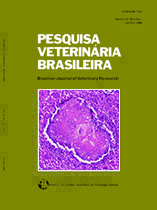 |
|
|
|
Year 2017 - Volume 37, Number 11
|

|
Anatomy description of cervical region and hyoid apparatus in living giant anteaters Myrmecophaga tridactyla Linnaeus, 1758, 37(11):1345-1351
|
ABSTRACT.- Borges N.C., Nardotto J.R.B., Oliveira R.S.L., Rüncos L.H.E., Ribeiro R.G. & Bogoevich A.M. 2017. Anatomy description of cervical region and hyoid apparatus in living giant anteaters Myrmecophaga tridactyla Linnaeus, 1758. Pesquisa Veterinária Brasileira 37(11):1345-1351. Setor de Diagnóstico por Imagem, Escola de Veterinária e Zootecnia, Universidade Federal de Goiás, Campus Samambaia, Cx. Postal 131, Goiânia, GO 74001-970, Brazil. E-mail: naidaborges@yahoo.com.br
The giant anteater has specific anatomical adaptations resulting from its ant and termite feeding habits. The unique arrangement of its hyoid apparatus is essential for the ingestion of food. However, its description in the literature is based on fragments and fossils, making it difficult to determine existing anatomical details in live animals. Imaging techniques, which enable the topographical anatomy of animals to be examined noninvasively, provide essential information for the diagnosis and prognosis of diseases. The aim of this study is to describe the bone contours in the hyoid apparatus of the giant anteater by means of radiographic and tomographic images. Giant anteaters of varying ages from the Wild Animal Screening Center (CETAS-GO) were used, seven for X-ray exams and two adults for CT exams. The hyoid elements in all the animals were evaluated using the two imaging techniques, and were visualized in the cervical region of C2 to C6, which comprises three paired bones (stylohyoid, epihyoid, ceratohyoid) and one unpaired bone (basihyoid). The presence of air in the oropharynx enabled the assessment of soft tissue structures in this region, such as the epiglottis and the soft palate. CT axial sections are of limited usefulness for evaluating the hyoid bones, but enable assessments of the basihyoid bone and its characteristic V-shape. Thus, to analyze the hyoid region in anteaters based on radiographic and tomographic images, one must keep in mind that the stylohyoid, epihyoid and ceratohyoid bones are situated ventrally to the C2 to C5 vertebrae and that the basihyoid at the level of C5-C6 demarcates the transition between the nasopharynx and the trachea. The nasopharynx and oropharynx extend from C1 to C5, and the trachea begins at the level of C6 |
| |
|
|
| |
|
 |